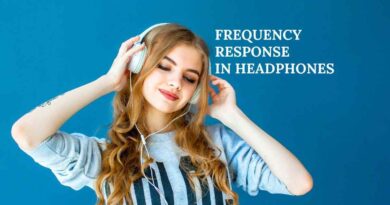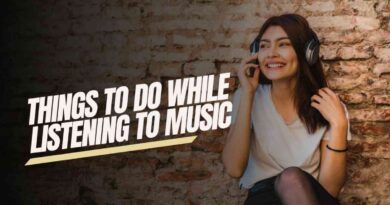Why Do Musicians Wear Headphones?
Musicians and their headphones – a common sight on stages, in studios, and even during casual jam sessions. But have you ever wondered why these professionals always have those cans on their ears? In this blog post, we’ll explore why musicians wear headphones. Whether it’s to improve their listening experience or facilitate communication within a band, these seemingly basic devices play a vital role in the music creation process
So Why Do Musicians Wear Headphones?
There are two main reasons you’ll see musicians wearing headphones: for better monitoring (hearing themselves and the music clearly) and to protect their hearing. Apart from this, there are other reasons we’re going to discuss here. Read on.
Monitoring
Musicians rely on headphones to accurately hear the sound they’re producing or playing. These headphones, often referred to as studio monitors or reference headphones, provide a faithful reproduction of the audio signal. This means that musicians can discern the nuances of their performance, from the subtlest nuances of a guitar riff to the clarity of a vocalist’s pitch.
Moreover, monitoring allows musicians to fine-tune their performance in real-time. Whether it’s adjusting the levels of individual instruments or perfecting harmonies, headphones provide the necessary feedback for musicians to deliver their best. In studio environments, where precision is paramount, monitoring headphones serve as indispensable tools for capturing pristine recordings.
Noise Isolation and Focus
In the midst of a bustling studio or a noisy stage, maintaining focus is key for musicians. This is where headphones with noise isolation capabilities come into play. By creating a physical barrier between the ears and the external environment, these headphones block out unwanted distractions and ambient noise. This isolation fosters a conducive atmosphere for concentration, allowing musicians to immerse themselves fully in their performance or recording session.
Furthermore, noise isolation headphones enable musicians to hear themselves more clearly amidst the cacophony of sound. This clarity is essential for ensuring precise timing, intonation, and dynamics, particularly in live performance settings where distractions abound. Whether it’s a drummer keeping time, a bassist locking into the groove, or a vocalist hitting the perfect note, noise isolation headphones facilitate precision and cohesion within the ensemble.
Additionally, for musicians who are recording vocals or acoustic instruments, noise isolation headphones prevent sound leakage into microphones, ensuring clean and pristine recordings. This level of control over the audio environment is invaluable in achieving professional-quality results.
Communication in Studio Settings
Effective communication is the cornerstone of successful music production, especially in studio settings where multiple musicians and engineers collaborate. Headphones play a vital role in facilitating this communication by enabling real-time interaction and feedback among team members.
In a recording studio, musicians often wear headphones connected to a monitoring system that allows them to hear themselves, as well as the playback of previously recorded tracks. Simultaneously, engineers and producers use headphones to monitor the overall mix and make adjustments as needed. This synchronized listening ensures that everyone involved in the recording process remains on the same page, working towards a cohesive and polished final product.
Moreover, headphones equipped with talkback features enable seamless communication between musicians and engineers. With the press of a button, musicians can communicate with the control room, discussing performance nuances, requesting changes in their monitor mix, or seeking clarification on production directions. This real-time dialogue streamlines the recording process, minimizing downtime and maximizing productivity.
Furthermore, headphones serve as a means of cueing and synchronization during live performances. In situations where musicians rely on click tracks or backing tracks, headphones provide a direct audio feed, keeping everyone in sync with the performance. This synchronized playback ensures tight performances and seamless transitions between songs, enhancing the overall live experience for both musicians and audience alike.
Hearing Protection
While creating music is undoubtedly fulfilling, it’s also important to prioritize the health and well-being of musicians, including their hearing. Exposure to high sound levels, whether in a live concert or a studio environment, can lead to irreversible hearing damage over time. This is where headphones serve a dual purpose: not only do they facilitate music-making, but they also act as a crucial tool for hearing protection.
Modern headphones are designed with built-in features such as noise-canceling technology and volume-limiting capabilities to safeguard musicians’ ears from excessive sound pressure levels. By wearing headphones, musicians can control the intensity of the sound they’re exposed to, reducing the risk of hearing loss and related issues such as tinnitus.
In live performance settings, where sound levels can reach deafening levels, headphones provide a barrier between the ears and the amplified sound, offering a degree of protection against noise-induced hearing damage. Similarly, in studio environments where prolonged exposure to loud music is common, headphones help mitigate the risk of hearing fatigue and long-term hearing impairment.
Furthermore, for musicians who frequently perform or practice with amplified instruments, such as drummers or guitarists, wearing headphones with built-in ear protection is essential for preserving their hearing sensitivity. By adopting proactive measures such as using headphones with adequate noise attenuation, musicians can enjoy a long and healthy career in music without compromising their auditory health.
Wireless Technology Advancements
In recent years, wireless technology has made significant strides, revolutionizing the way musicians interact with their headphones. Gone are the days of being tethered to audio interfaces or mixing consoles by cumbersome cables. Today, wireless headphones offer musicians unprecedented freedom of movement without sacrificing audio quality or reliability.
One of the key advantages of wireless headphones is their versatility in both studio and live performance settings. Musicians can move freely around the stage or studio without being encumbered by cables, allowing for dynamic performances and seamless interactions with bandmates or collaborators. This newfound mobility enhances creativity and spontaneity, enabling musicians to explore new sonic landscapes without being confined to a fixed position.
Moreover, wireless headphones simplify the monitoring process, particularly in multi-track recording sessions or live sound reinforcement scenarios. With the ability to connect to multiple audio sources simultaneously, musicians can easily switch between different monitor mixes or cue tracks, streamlining the workflow and ensuring smooth transitions between songs or takes.
Additionally, wireless headphones offer enhanced comfort and convenience for musicians during extended recording sessions or marathon rehearsals. Without the hassle of tangled cables or restrictive cords, musicians can focus entirely on their performance, optimizing their creative output and minimizing distractions.
Furthermore, advancements in battery technology have extended the runtime of wireless headphones, allowing musicians to enjoy uninterrupted playback for extended periods. Whether tracking a full-length album in the studio or embarking on a world tour, wireless headphones provide reliable performance and peace of mind for musicians at every stage of their journey.
Conclusion
The ubiquitous presence of headphones among musicians serves a multitude of purposes, each contributing to the overall music-making process. From monitoring and noise isolation to communication and hearing protection, these seemingly humble accessories play a crucial role in enhancing both the creative experience and the quality of the final product.
Through the use of headphones, musicians can fine-tune their performances, collaborate effectively with bandmates and engineers, and safeguard their auditory health for years to come. Furthermore, advancements in wireless technology have ushered in a new era of freedom and flexibility, allowing musicians to explore new realms of expression without being tethered by cables or constraints.
As technology continues to evolve and the demands of the music industry evolve, one thing remains constant: the importance of headphones in the arsenal of every musician. Whether you’re a seasoned professional or an aspiring artist, investing in a quality pair of headphones is an investment in your craft and your future as a musician.
So, the next time you see a musician donning a pair of headphones, remember that they’re not just listening to music – they’re actively shaping it, one note at a time.
With that, we wrap up our exploration of why musicians wear headphones. Thank you for joining me on this journey, and may your music always be in harmony.




